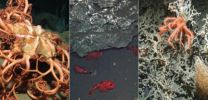(Press-News.org) As fishing and the harvesting of metals, gas and oil have expanded deeper and deeper into the ocean, scientists are drawing attention to the services provided by the deep sea, the world's largest environment. "This is the time to discuss deep-sea stewardship before exploitation is too much farther underway," says lead-author Andrew Thurber. In a review published today in Biogeosciences, a journal of the European Geosciences Union (EGU), Thurber and colleagues summarise what this habitat provides to humans, and emphasise the need to protect it.
"The deep sea realm is so distant, but affects us in so many ways. That's where the passion lies: to tell everyone what's down there and that we still have a lot to explore," says co-author Jeroen Ingels of Plymouth Marine Laboratory in the UK.
"What we know highlights that it provides much directly to society," says Thurber, a researcher at the College of Earth, Ocean and Atmospheric Sciences at Oregon State University in the US. Yet, the deep sea is facing impacts from climate change and, as resources are depleted elsewhere, is being increasingly exploited by humans for food, energy and metals like gold and silver.
"We felt we had to do something," says Ingels. "We all felt passionate about placing the deep sea in a relevant context and found that there was little out there aimed at explaining what the deep sea does for us to a broad audience that includes scientists, the non-specialists and ultimately the policy makers. There was a gap to be filled. So we said: 'Let's just make this happen'."
In the review of over 200 scientific papers, the international team of researchers points out how vital the deep sea is to support our current way of life. It nurtures fish stocks, serves as a dumping ground for our waste, and is a massive reserve of oil, gas, precious metals and the rare minerals we use in modern electronics, such as cell phones and hybrid-car batteries. Further, hydrothermal vents and other deep-sea environments host life forms, from bacteria to sponges, that are a source of new antibiotics and anti-cancer chemicals. It also has a cultural value, with its strange species and untouched habitats inspiring books and films from 20,000 Leagues Under the Sea to Finding Nemo.
"From jewellery to oil and gas and future potential energy reserves as well as novel pharmaceuticals, deep-sea's worth should be recognised so that, as we decide how to use it more in the future, we do not inhibit or lose the services that it already provides," says Thurber.
The deep sea (ocean areas deeper than 200m) represents 98.5% of the volume of our planet that is hospitable to animals. It has received less attention than other environments because it is vast, dark and remote, and much of it is inaccessible to humans. But it has important global functions. In the Biogeosciences review the team shows that deep-sea marine life plays a crucial role in absorbing carbon dioxide from the atmosphere, as well as methane that occasionally leaks from under the seafloor. In doing so, the deep ocean has limited much of the effects of climate change.
This type of process occurs over a vast area and at a slow rate. Thurber gives other examples: manganese nodules, deep-sea sources of nickel, copper, cobalt and rare earth minerals, take centuries or longer to form and are not renewable. Likewise, slow-growing and long-lived species of fish and coral in the deep sea are more susceptible to overfishing. "This means that a different approach needs to be taken as we start harvesting the resources within it."
By highlighting the importance of the deep sea and identifying the traits that differentiate this environment from others, the researchers hope to provide the tools for effective and sustainable management of this habitat.
"This study is one of the steps in making sure that the benefits of the deep sea are understood by those who are trying to, or beginning to, regulate its resources," concludes Thurber. "We ultimately hope that it will be a useful tool for policy makers."
INFORMATION:
Please mention the name of the publication (Biogeosciences) if reporting on this story and, if reporting online, include a link to the paper or to the journal website (http://www.biogeosciences.net/).
From 'Finding Nemo' to minerals -- what riches lie in the deep sea?
2014-07-29
ELSE PRESS RELEASES FROM THIS DATE:
Genomic analysis of prostate cancer indicates best course of action after surgery
2014-07-29
(PHILADELPHIA) – There is controversy over how best to treat patients after they've undergone surgery for prostate cancer. Does one wait until the cancer comes back or provide men with additional radiation therapy to prevent cancer recurrence? Now, a new study from Thomas Jefferson University shows that a genomic tool can help doctors and patients make a more informed decision.
"We are moving away from treating everyone the same," says first author Robert Den, M.D., Assistant Professor of Radiation Oncology and Cancer Biology at Thomas Jefferson University. "Genomic ...
Optimum inertial self-propulsion design for snowman-like nanorobot
2014-07-29
Scale plays a major role in locomotion. Swimming microorganisms, such as bacteria and spermatozoa, are subjected to relatively small inertial forces compared to the viscous forces exerted by the surrounding fluid. Such low-level inertia makes self-propulsion a major challenge. Now, scientists have found that the direction of propulsion made possible by such inertia is opposite to that induced by a viscoelastic fluid. These findings have been published in EPJ E by François Nadal from the Alternative Energies and Atomic Energy Commission (CEA), in Le Barp, France, and colleagues. ...
Team studies the social origins of intelligence in the brain
2014-07-29
CHAMPAIGN, Ill. — By studying the injuries and aptitudes of Vietnam War veterans who suffered penetrating head wounds during the war, scientists are tackling -- and beginning to answer -- longstanding questions about how the brain works.
The researchers found that brain regions that contribute to optimal social functioning also are vital to general intelligence and to emotional intelligence. This finding bolsters the view that general intelligence emerges from the emotional and social context of one's life.
The findings are reported in the journal Brain.
"We are ...
NOAA: Alaska fisheries and communities at risk from ocean acidification
2014-07-29
Ocean acidification is driving changes in waters vital to Alaska's valuable commercial fisheries and subsistence way of life, according to new NOAA-led research that will be published online in Progress in Oceanography.
Many of Alaska's nutritionally and economically valuable marine fisheries are located in waters that are already experiencing ocean acidification, and will see more in the near future, the study shows. Communities in southeast and southwest Alaska face the highest risk from ocean acidification because they rely heavily on fisheries that are expected to ...
Preterm children's brains can catch up years later
2014-07-29
There's some good news for parents of preterm babies – latest research from the University of Adelaide shows that by the time they become teenagers, the brains of many preterm children can perform almost as well as those born at term.
A study conducted by the University's Robinson Research Institute has found that as long as the preterm child experiences no brain injury in early life, their cognitive abilities as a teenager can potentially be as good as their term-born peers.
However, the results of the study, published in this month's issue of The Journal of Pediatrics, ...
New anesthesia technique helps show cause of obstruction in sleep apnea
2014-07-29
July 29, 2014 – A simplified anesthesia procedure may enable more widespread use of preoperative testing to demonstrate the cause of airway obstruction in patients with severe sleep apnea, suggests a study in Anesthesia & Analgesia.
Dr. Joshua H. Atkins and Dr. Jeff E. Mandel of the University of Pennsylvania and their colleagues have developed a new "ramp control" anesthetic technique for putting patients to sleep briefly-just enough to show the "obstructive anatomy" responsible for sleep apnea. The simplified technique requires no special expertise and limits drops ...
Mysterious esophagus disease is autoimmune after all
2014-07-29
Achalasia is a rare disease – it affects 1 in 100,000 people – characterized by a loss of nerve cells in the esophageal wall. While its cause remains unknown, a new study by a team of researchers at KU Leuven in Belgium, the University of Bonn in Germany and other European institutions confirms for the first time that achalasia is autoimmune in origin. The study, published on 6 July in Nature Genetics, is an important step towards unraveling the mysterious disease.
When we swallow, a sphincter in the lower esophagus opens, allowing food to enter the stomach. Nerve cells ...
Worldwide water shortage by 2040
2014-07-29
Two new reports that focus on the global electricity water nexus have just been published. Three years of research show that by the year 2040 there will not be enough water in the world to quench the thirst of the world population and keep the current energy and power solutions going if we continue doing what we are doing today. It is a clash of competing necessities, between drinking water and energy demand. Behind the research is a group of researchers from Aarhus University in Denmark, Vermont Law School and CNA Corporation in the US.
In most countries, electricity ...
Mortality rates increase due to extreme heat and cold
2014-07-29
Epidemiological studies have repeatedly shown that death rates rise in association with extremely hot weather. The heat wave in Western Europe in the summer of 2003, for example, resulted in about 22,000 extra deaths. A team of researchers led by Dr. Alex-andra Schneider at the Institute of Epidemiology II at the Helmholtz Zentrum München examined the impact of extreme temperatures on the number of deaths caused by cardiovascular disease in three Bavarian cities and included both high and low temperatures in the study.
"Our findings confirm the results of our previous ...
A new brain-based marker of stress susceptibility
2014-07-29
DURHAM, N.C. -- Some people can handle stressful situations better than others, and it's not all in their genes: Even identical twins show differences in how they respond.
Researchers have identified a specific electrical pattern in the brains of genetically identical mice that predicts how well individual animals will fare in stressful situations.
The findings, published July 29 in Nature Communications, may eventually help researchers prevent potential consequences of chronic stress -- such as post-traumatic stress disorder, depression and other psychiatric disorders ...


